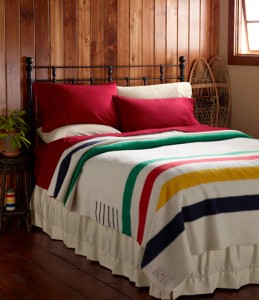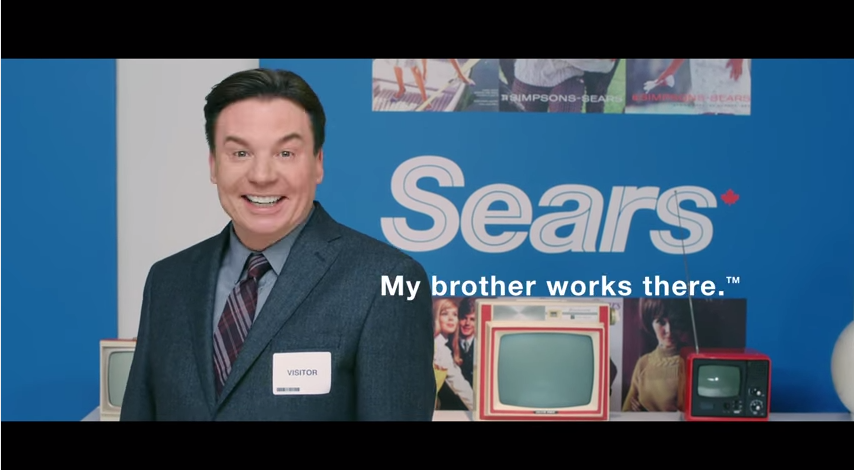Everyone has bad weeks. Weeks where bad news keeps piling up and it never ends.
But no one has had a week like Sears.
First, their card payment provider terminates their contract.
Then, two days later, Sears reports Q3 losses more than double what was projected.
That day, shares fell over 5% and continue to drop.
Lastly, Sears released their #mybrotherworksatsears campaign featuring comedian Mike Myers and his Sears-employed brother—in the midst of all that negative noise. Some wonder if the noise is going to continue drowning out their hopeful and hilarious message.
But much of what Sears is experiencing was completely predictable, especially from a brand perspective.
Let me clarify with a little history:

This is me with my favourite Sears score, the 1984 rainbow suspenders. I loved them so much, I refused to wear jeans!
When I was a kid, the Sears catalog was the dominant presence around the kitchen table. Living in rural Nova Scotia, the Sears catalog was the conversation starter during the fall and winter months. It was our coffee table book and our Christmas wish lists, and the pages made great kindling for the fire (the pages we didn’t cut out and plaster on the fridge to subtly remind our parents).
Sears wasn’t just a department store.
It was a product distribution mechanism that sold through the mail and through their mail outlets. Those ramshackle commercial cabins were peppered throughout rural Nova Scotia as well as the rest of Canada.
Whenever my family drove into Halifax (which was once every two to three weeks), Eaton’s, Simpsons, Sears, Canadian Tire and the Bay were often our main stops. Department store living was a reality in the ‘80s.
What Sears did so successfully was to be known in urban locales as a department store, while it remained a distribution chain in rural areas.
“Two separate customer bases with unique experiences, one fine brand.”
Today, Sears is fighting to remain relevant, and it’s not looking good. Market forces are working against them. More agile warehouse stores are under-cutting them, while mid-priced stores have done a better job marketing their brands and keeping things in their favour.
Scour through the comments section of any news story on Sears (like this one) and read the top complaints:
- Price
- Expectations not being met in store (warranty, customer service)
- Confusion in the customer experience
All of these problems with their customers could be alleviated with a strengthened brand promise.
Consider some of their competition.

Their slogan is their rallying cry, philosophy and reason for being all in one.
Walmart has a lower customer service experience to Sears, but people don’t complain as fervently about Walmart’s customer service. Walmart customers expect bare-bones service because that is what was promised them. Save money. Live better is not just a slogan; it’s a promise. Walmart keeps to it, and that what keeps people coming.

This logo can be seen on everything, from bags to sweaters to building facades. It’s the corporate crest from 1769, so it screams legacy.
The Bay is one competitor to Sears—similar in form, price point and sector.
It really is the last of the Great Canadian Department Stores after the death of Eaton’s which suffered a gory death from mismanagement in 1999.
It was also the first great Canadian, well, anything. The Bay’s brand promise is longevity and legacy. Their stylized blankets are a huge seller (and a boon for charity marketing) because the brand is so closely attached to our history, and they embraced that story (despite the darker documentation of the Hudson’s Bay Co. handing out infected blankets to wipe out the native population of Fort Pitt in the 1760s). We see the Bay’s Coat of Arms and multi colour stripe blanket and we think originally Canadian.
And the Bay’s become a point of pride for its customers.

The black stripes on the Hudson Bay blanket marked the size, which could be seen even while folded. The US owners of the Bay brought them back, nearly 230 years after they were first traded for furs with First Nations people.
Couple this with their modernized fashion and furniture inventory to appeal to younger buyers, and you’ve got a powerful brand promise. An anchor of the past and a beacon of the future. It took the Bay’s American owners to get wise and apply it to every part of the company, and face the truth up front—even the uglier stuff. That’s a demonstration of brand character, and it’s what brought me and my wife back to the Bay after we left it for nearly 10 years. (Ironically it was my style consultant who dragged us kicking and screaming at first, but we’re happy she did!)
In the last year, the Bay have been even more innovative in developing partnerships with well known and respected brands:
- Ben Sherman, a men’s indie fashion brand of 20 years
- Dwell Furniture, which is usually only found in higher end furniture stores, and
- Kleinfields, the established bridal gowns maker (this is also the first time they’ve crossed the border)
Sears has a Canadian tradition that’s more than two generations old. Looking back, I can remember how us rural Nova Scotian families would covet our catalogues for weeks, and then we’d await the delivery of the goods to the outlet by imagining the incredible journeys our washing machine and Christmas stocking stuffers made in getting to our humble homes.
What’s an easy way to define brand?
These are the aspects of brand that count. History, customer experience, expectation and promise. Clarifying that is the defining treasure of any business because it humanizes what you do and why you are here doing it. It gives you purpose, and that gives us purpose as your prospect or your lead.
Sears is suffering from a deep branding conundrum. No one knows what Sears is (including the executive), and no one remembers the history and culture. I don’t know what to expect when I get there. Some thing are cheaper than the Bay, some are more expensive. Some things are cheaper than Canadian Tire, others more expensive. but no one touches Walmart. Ever. Sure, I don’t know that, but I believe it.
This is the power of brand. Your customers become you. What you tell them they want to believe because they want to have a relationship with your brand. This is the nature of customer behaviour.
So take the time to figure out what you are to your customers.
If you find out and it’s what you’ve already been saying, great! Say it to more prospects and give your brand story life. If the brand promise you tell prospects isn’t what your customers think it is, you have some work to do.
But even if your brand isn’t connecting to your customers, you can fix it. The Bay turned itself around, and there are plenty of companies that have clawed their way back.
Another notable recovery is underway with Target Canada, which had the worst launch in the history of department stores. Their slogan: Expect more. Pay less, was not in tune with what Canadians thought they were getting. Instead, short-staffed barren warehouses was what shoppers got, and it cost them 1 billion dollars. They are re-engaging with Canadians and it seems to be working (doing things like calling us guests shows that they are looking at Canadians differently).
Real Estate’s brand lesson from Sears is this:
If you are not clear on,
who you are
what you offer, and
what people can expect when they work with you
you will likely end up in exactly the same position as Sears.
The irrelevant one.
Give the story of your business the life it deserves. It’s the one thing that will preserve it in the mind of your customers, and it’s the rallying cry for you and your team when the chips are down.
If you want to learn about how to discover, develop and Amplify Your Brand, stay tuned. In a couple of weeks we will be launching something very special for you.
In the meantime, here are some excellent sources to inspire and engage you and your customers.
The Science and Art of Branding by Giep Franzen and Sandra Moriarty
Emotional Branding (this is the book some say got Obama elected)
For those without the time for lengthy reads, check the branding articles and blog posts on these websites:
Sign-up For FREE Updates


